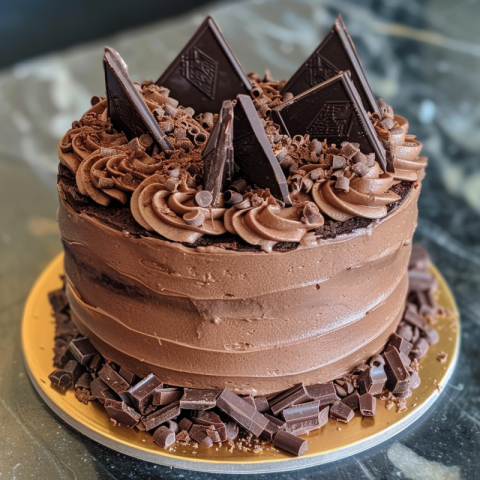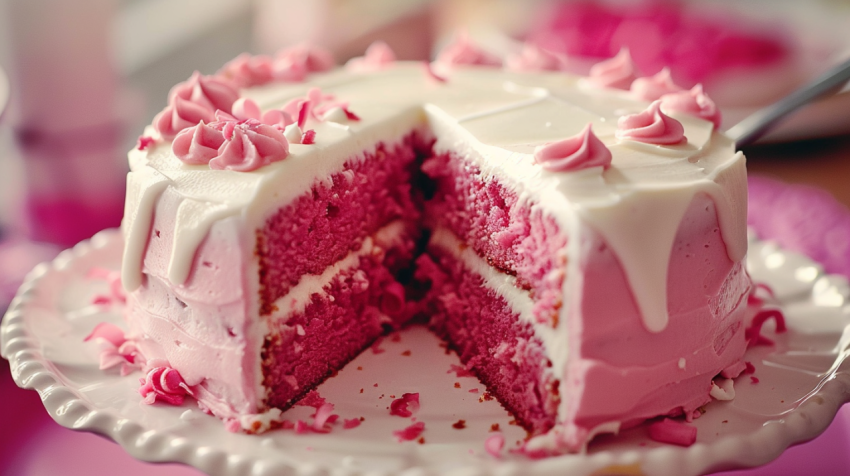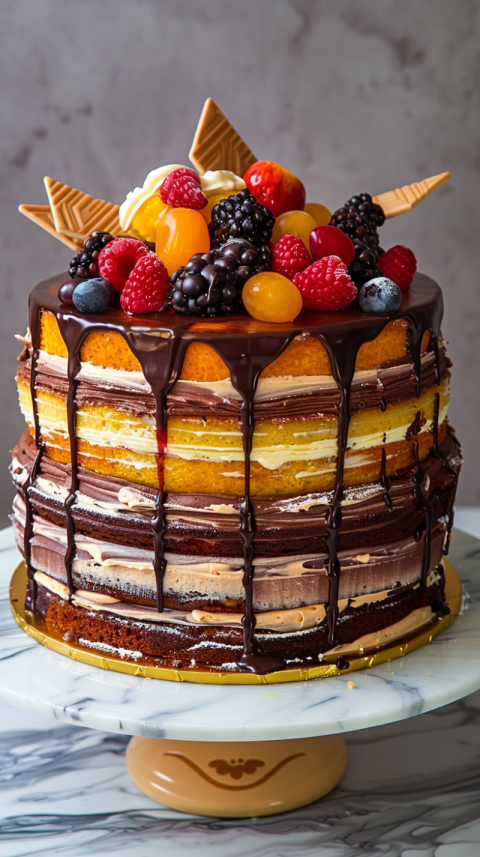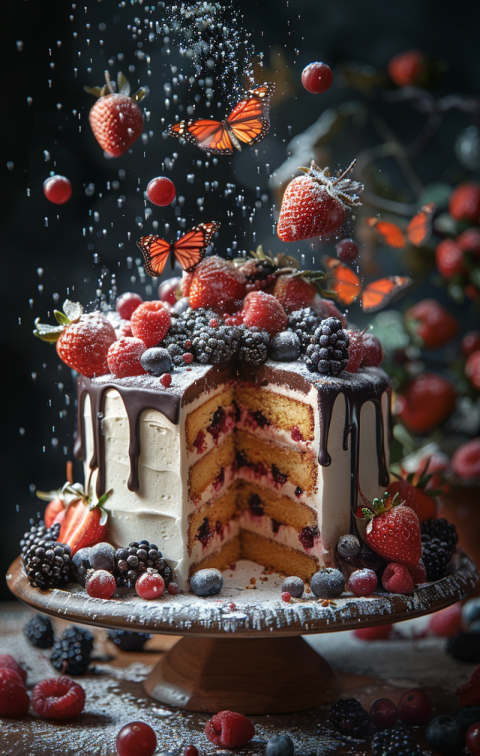











Cake: A Sweet History and Celebration of Flavors and Forms
Cake, a beloved baked good, is a cornerstone of celebrations, a comforting treat, and a testament to the artistry of baking. From simple sponge cakes to elaborate multi-tiered creations, cakes come in a vast array of flavors, textures, and forms. Cake has a rich history, evolving from ancient flatbreads to the fluffy, sweet confections we know today. Its cultural significance is undeniable, marking birthdays, weddings, and countless other special occasions.
1. The Origins of Cake: From Ancient Grains to Sweet Indulgence
The history of cake stretches back to antiquity:
- Ancient civilizations, including the Egyptians, Greeks, and Romans, made flatbreads that were often sweetened with honey or dates. These were the early precursors to modern cake.
- The ancient Egyptians are known to have been skilled bakers and even had bakeries. They made an early form of cake using honey, and their cakes were found in the tombs of pharaohs.
- The word "cake" itself comes from the Old Norse word "kaka."
- During the Middle Ages, cakes in Europe were often dense and fruit-laden, more similar to fruitcakes.
- The development of refined sugar in the 17th century revolutionized cake baking, making it possible to create lighter and sweeter cakes.
- The invention of baking powder and baking soda in the 19th century further transformed cake baking, leading to the rise of the fluffy, airy cakes we enjoy today.
2. Types of Cake: A World of Variety
Cakes can be broadly classified into several categories based on their ingredients, mixing methods, and leavening agents:
- Butter Cake (Creaming Method): These cakes are made by creaming together butter and sugar, then adding eggs, flour, and a leavening agent like baking powder. Examples include pound cake, yellow cake, and many layer cakes.
- Sponge Cake (Foam Cake): These cakes rely on whipped eggs or egg whites for their airy texture. They contain little to no fat and are often light and delicate. Examples include angel food cake, chiffon cake, and genoise.
- Chiffon Cake: A variation of the sponge cake that includes oil for added moisture.
- Flourless Cake: Cakes made without wheat flour, often using ingredients like almond flour, cocoa powder, or pureed beans. Examples include flourless chocolate cake and some types of cheesecake.
- Cheesecake: While technically a type of pie, cheesecake is often included in discussions about cake. They are made with a cream cheese base and can be baked or unbaked.
- Carrot Cake: A spiced cake that includes grated carrots for moisture and flavor, usually topped with a cream cheese frosting.
- Red Velvet Cake: A cake with a distinctive red color, traditionally achieved using a reaction between cocoa powder and acidic ingredients like buttermilk and vinegar. Now often made with red food coloring. It is usually topped with a cream cheese frosting.
- Fruitcake: A dense cake packed with dried fruits and nuts, often soaked in alcohol.
- Coffee Cake: A cake that is often served with coffee, usually having a streusel topping.
3. Cake Ingredients: The Building Blocks of Deliciousness
The basic ingredients in most cakes include:
- Flour: Provides structure to the cake. Different types of flour, such as all-purpose, cake flour, and self-rising flour, can be used depending on the desired texture.
- Sugar: Adds sweetness and moisture, and contributes to browning.
- Eggs: Provide structure, richness, and leavening.
- Fat: Butter, oil, or shortening adds tenderness, moisture, and flavor.
- Leavening Agents: Baking powder, baking soda, or yeast create air pockets in the batter, causing the cake to rise.
- Liquid: Milk, water, or juice adds moisture and helps to bind the ingredients together.
- Flavorings: Extracts, spices, chocolate, fruits, and nuts add flavor and variety to cakes.
4. Cake Baking Techniques: Mastering the Art of the Bake
Baking a successful cake involves understanding and applying various techniques:
- Creaming: Beating together butter and sugar until light and fluffy, incorporating air into the batter.
- Whipping: Beating egg whites until they form stiff peaks, creating a light and airy texture.
- Folding: Gently incorporating ingredients, often whipped egg whites, into a batter without deflating the air.
- Measuring: Accurate measurement of ingredients is crucial for successful cake baking.
- Mixing: Overmixing can develop too much gluten and result in a tough cake.
- Baking: Using the correct oven temperature and baking time is essential for a properly baked cake.
- Cooling: Cakes should be cooled properly to prevent them from sticking to the pan or becoming soggy.
5. Cake Decorating: From Simple Frosting to Elaborate Art
Cake decorating is an art form in itself, ranging from simple frosting to elaborate designs:
- Frosting/Icing: A sweet coating used to cover and decorate cakes. Common types include buttercream, cream cheese frosting, and royal icing.
- Fondant: A pliable sugar paste that can be rolled out and used to cover cakes, creating a smooth, seamless surface.
- Piping: Using a pastry bag and various tips to create decorative borders, flowers, and other designs.
- Sprinkles: Small, colorful pieces of sugar used to add a festive touch to cakes.
- Edible Decorations: A wide range of edible decorations, such as sugar flowers, chocolate shavings, and fresh fruit, can be used to enhance the appearance of cakes.
6. Cakes Around the World: Cultural Variations
Different cultures have their own unique cake traditions:
- Germany: Black Forest cake (Schwarzwalder Kirschtorte), a chocolate cake layered with whipped cream and cherries.
- France: The French are renowned for their pastries and cakes, including the gateau, the opera cake, and the croquembouche.
- Italy: Panettone, a sweet bread-like cake traditionally eaten at Christmas, and tiramisu, a coffee-flavored dessert that often includes cake layers.
- Japan: Japanese Christmas cake is a sponge cake with whipped cream and strawberries. They also have a variety of cakes made with ingredients such as matcha and red bean paste.
- Mexico: Tres Leches cake, a sponge cake soaked in three kinds of milk.
7. The Role of Cake in Celebrations: Marking Special Occasions
Cake plays a central role in many celebrations:
- Birthdays: Birthday cakes, often decorated with candles, are a traditional part of birthday celebrations.
- Weddings: Wedding cakes are often elaborate, multi-tiered creations that serve as a centerpiece of the reception.
- Anniversaries: Cakes are often used to celebrate anniversaries, graduations, and other special milestones.
- Holidays: Many holidays, such as Christmas and Easter, have traditional cakes associated with them.
8. The Future of Cake
- Baking trends are constantly evolving, with new flavors, techniques, and dietary considerations emerging.
- Vegan, gluten-free, and other specialized cakes are becoming increasingly popular.
- Cake decorating continues to push creative boundaries, with innovative designs and techniques being developed.
Conclusion:
Cake is more than just a dessert; it's a symbol of celebration, a source of comfort, and a testament to the artistry of baking. From its ancient origins to the diverse and delicious creations of today, cake has a rich history and a bright future. Whether you're a seasoned baker or simply a lover of sweet treats, the world of cake offers endless opportunities for exploration, creativity, and indulgence. Its enduring popularity and cultural significance ensure that cake will continue to be a beloved part of our lives for generations to come.
Cake, types of cake, cake recipes, cake decorating, butter cake, sponge cake, chiffon cake, pound cake, chocolate cake, vanilla cake, red velvet cake, carrot cake, cheesecake, birthday cake, wedding cake, cupcakes, cake pops, cake frosting, cake icing, buttercream, fondant, baking powder, baking soda, cake flour, cake pan, how to bake a cake, cake decorating ideas, easy cake recipes, best cake recipes, cake history, cake shop near me, order cake online, vegan cake, gluten-free cake.

